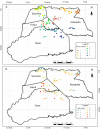Cacao (Theobromacacao L.) climate zones and its associated agrobiodiversity in Arauca, Colombia
- PMID: 38078291
- PMCID: PMC10698748
- DOI: 10.3897/BDJ.11.e112771
Cacao (Theobromacacao L.) climate zones and its associated agrobiodiversity in Arauca, Colombia
Abstract
Background: Cacao (Theobromacacao L) is one of the most relevant crops in terms of economy and social rural development in Colombia. Cacao is also an important crop due to its potential to replace illicit crops and it is related to less deforestation and preserves the biodiversity. There are several cacao districts in Colombia, one of these being Arauca. The Department of Arauca is the second largest cocoa producing region in Colombia; however, it is heavily affected by armed conflict. To raise the knowledge and technology available in the region, integrating data on the occurrence of cacao farms with climatic variables becomes a powerful socioeconomic mapping tool for maintaining agrobiodiversity and food security in the region. Consequently, this type of agrodiversity data and agroclimatic approaches help to better manage agrobiodiversity, as in the cacao region of Arauca. These tools are even more relevant in biodiverse regions, such as flooded savannahs and tropical forest ecosystems, which are currently undergoing drastic changes due to agricultural expansion and climate change. One of the knowledge gaps in Colombia´s cacao regions is that there are currently no agroclimatic maps made with a social and scientific approach. This study aimed to provide a database of the spatial distribution of cacao farms in Arauca, as well as agroclimatic maps that identify and locate cacao climate regions in Arauca. We also present a presence-only matrix consisting of twenty-six tree species, or agrobiodiversity, distributed across the study region and specifically associated with the cacao forestry systems in Arauca.
New information: We present the first database of both climate and agrobiodiversity data related to cacao farms in Arauca, developed with a research and socioeconomic vision that generated a novel approach for the agroclimatic zoning of cocoa in the Arauca Region and Colombia. Using 1,538 cacao farms at the regional scale, we identified two national and six regional-scale climate and soil regions. The selection at the local scale allowed us to classify 180 cacao farms comprising nine agroclimatic clusters in Arauca. We found twenty-six tree species distributed across the cacao climate zones. This dataset and its related maps also represent the agrobiodiversity of cultivated cacao locally. This is the most complete climate and agrobiodiversity dataset of cacao farms distribution in one of the top cocoa-producing regions in the country. These outputs are crucial because they constitute a baseline for developing research in the biodiversity of agroforestry systems, pests and diseases, pollutant presence, genetics, post-harvest processing and cocoa quality and safety.
Keywords: Arauca; Colombia; agrobiodiversity; chocolate; climate; conservation of cacao; soils.
Carlos Gonzalez-Orozco, Mario Porcel, Sebastian Escobar, Daniel Bravo, Yeisson Gutierrez Lopez, Roxana Yockteng, Fabrice Vaillant, Margareth Santander, Sandra Llano, Karla Parra, Esperanza Briceño, Jhony Carmona, Shirley Torres, Ramiro Contreras, Andres Mendez Otero, Allende Pesca, Gustavo Araujo Carrillo.
Figures


References
-
- Bravo D, Leon-Moreno C, Martínez CA, Varón-Ramírez VM, et al. The first national survey of cadmium in cacao farm soil in Colombia. Agronomy. 2021;(11):11–18.
-
- Bravo D. Bacterial cadmium-immobilization activity measured by isothermal microcalorimetry in cacao-growing soils From Colombia. Frontiersin Environmental Sciences. 2022;10:10:910234.
-
- Fick SE, Hijmans RJ. WorldClim 2: new 1-km spatial resolution climate surfaces for global land areas. International Journal of Climatology. 2017;37:4302–4315. doi: 10.1002/joc.5086. - DOI
-
- González-Orozco CE, Thornhill AH, Knerr N, Laffan S, Miller JT, et al. Biogeographical regions and phytogeography of the eucalypts. Diversity & Distributions. 2014;20:46–58. doi: 10.1111/ddi.12129. - DOI
-
- González-Orozco CE, Pesca A. Regionalization of cacao (Theobromacacao L.) in Colombia. Frontiers in Sustainable Food Systems. 2022;6:1–11.
LinkOut - more resources
Full Text Sources
